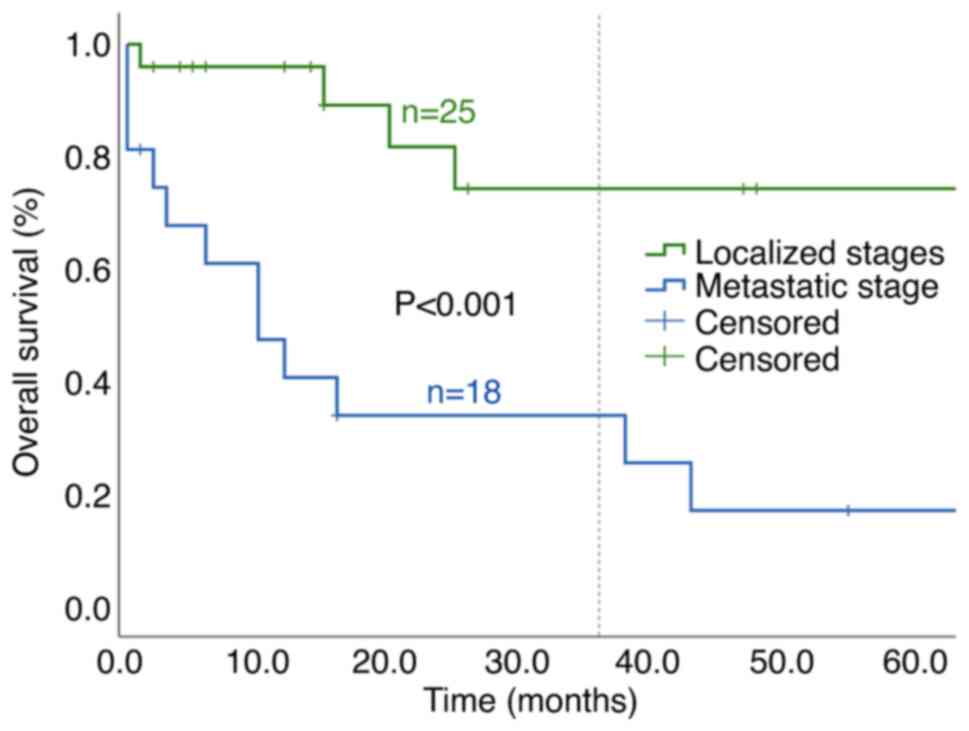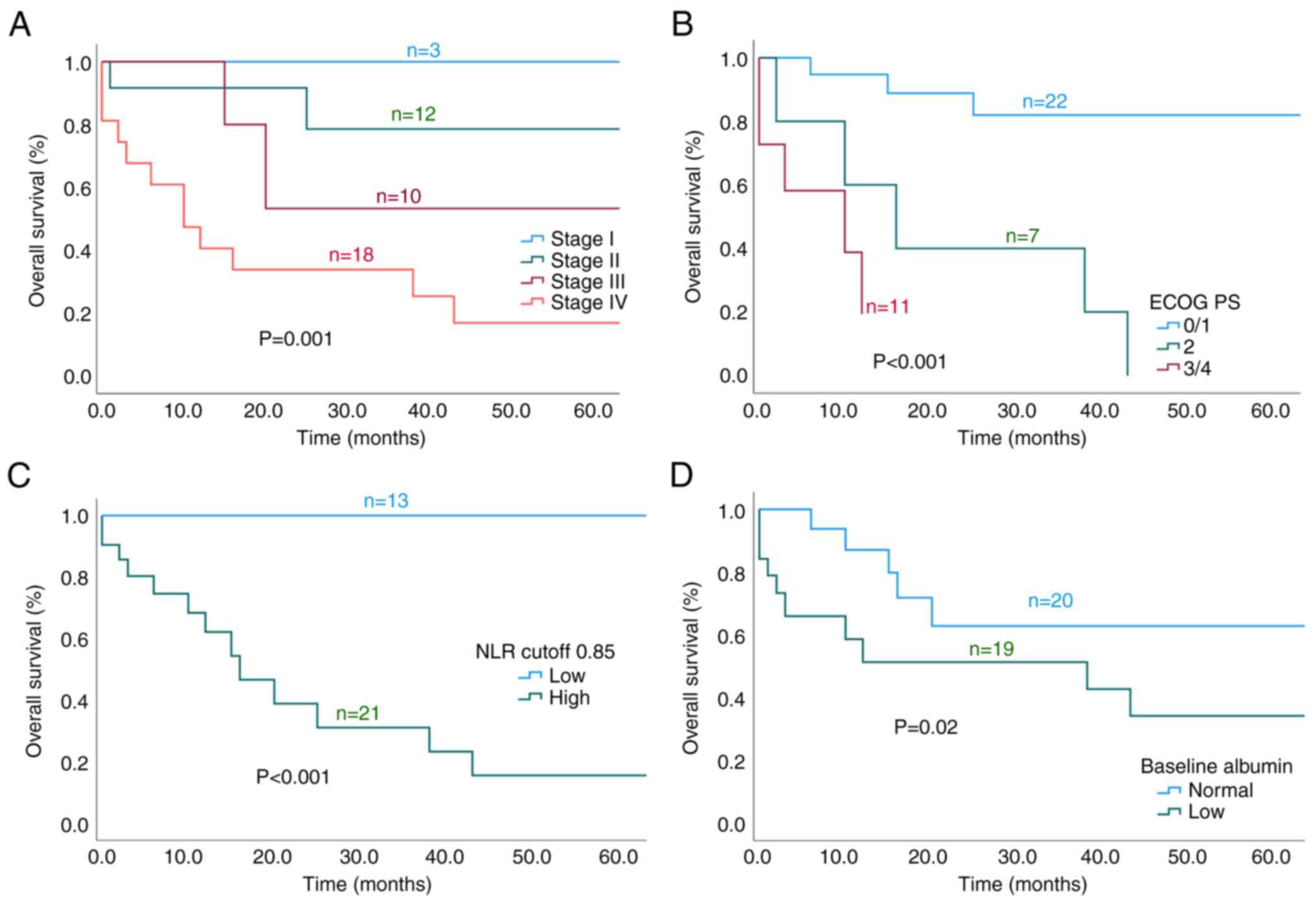|
1
|
Siegel RL, Miller KD, Fuchs HE and Jemal
A: Cancer statistics, 2022. CA Cancer J Clin. 72:7–33.
2022.PubMed/NCBI View Article : Google Scholar
|
|
2
|
Lepage C, Bouvier AM, Manfredi S, Dancourt
V and Faivre J: Incidence and management of primary malignant small
bowel cancers: A well-defined French population study. Am J
Gastroenterol. 101:2826–2832. 2006.PubMed/NCBI View Article : Google Scholar
|
|
3
|
Bilimoria KY, Bentrem DJ, Wayne JD, Ko CY,
Bennett CL and Talamonti MS: Small bowel cancer in the United
States: Changes in epidemiology, treatment, and survival over the
last 20 years. Ann Surg. 249:63–71. 2009.PubMed/NCBI View Article : Google Scholar
|
|
4
|
Schottenfeld D, Beebe-Dimmer JL and
Vigneau FD: The epidemiology and pathogenesis of neoplasia in the
small intestine. Ann Epidemiol. 19:58–69. 2009.PubMed/NCBI View Article : Google Scholar
|
|
5
|
Barsouk A, Rawla P, Barsouk A and Thandra
KC: Epidemiology of cancers of the small intestine: Trends, risk
factors, and prevention. Med Sci (Basel). 7(46)2019.PubMed/NCBI View Article : Google Scholar
|
|
6
|
Dabaja BS, Suki D, Pro B, Bonnen M and
Ajani J: Adenocarcinoma of the small bowel: Presentation,
prognostic factors, and outcome of 217 patients. Cancer.
101:518–526. 2004.PubMed/NCBI View Article : Google Scholar
|
|
7
|
Moon YW, Rha SY, Shin SJ, Chang H, Shim HS
and Roh JK: Adenocarcinoma of the small bowel at a single Korean
institute: Management and prognosticators. J Cancer Res Clin Oncol.
136:387–394. 2010.PubMed/NCBI View Article : Google Scholar
|
|
8
|
Aparicio T, Zaanan A, Svrcek M,
Laurent-Puig P, Carrere N, Manfredi S, Locher C and Afchain P:
Small bowel adenocarcinoma: Epidemiology, risk factors, diagnosis
and treatment. Dig Liver Dis. 46:97–104. 2014.PubMed/NCBI View Article : Google Scholar
|
|
9
|
Colina A, Hwang H, Wang H, Katz MHG, Sun
R, Lee JE, Thomas J, Tzeng CW, Wolff RA, Raghav K and Overman MJ:
Natural history and prognostic factors for localised small bowel
adenocarcinoma. ESMO Open. 5(e000960)2020.PubMed/NCBI View Article : Google Scholar
|
|
10
|
Lech G, Korcz W, Kowalczyk E, Słotwiński R
and Słodkowski M: Primary small bowel adenocarcinoma: Current view
on clinical features, risk and prognostic factors, treatment and
outcome. Scand J Gastroenterol. 52:1194–1202. 2017.PubMed/NCBI View Article : Google Scholar
|
|
11
|
Overman MJ: Recent advances in the
management of adenocarcinoma of the small intestine. Gastrointest
Cancer Res. 3:90–96. 2009.PubMed/NCBI
|
|
12
|
Hong SH, Koh YH, Rho SY, Byun JH, Oh ST,
Im KW, Kim EK and Chang SK: Primary adenocarcinoma of the small
intestine: Presentation, prognostic factors and clinical outcome.
Jpn J Clin Oncol. 39:54–61. 2009.PubMed/NCBI View Article : Google Scholar
|
|
13
|
Yanko E, Le D, Mahmood S, Ginther DN,
Chalchal HI, Kanthan R, Haider K, Zaidi A, Dueck DA, Ahmed O, et
al: Outcomes of patients with small intestine adenocarcinoma in a
canadian province: A retrospective multi-center population-based
cohort study. Cancers (Basel). 14(2581)2002.PubMed/NCBI View Article : Google Scholar
|
|
14
|
Harris PA, Taylor R, Minor BL, Elliott V,
Fernandez M, O'Neal L, McLeod L, Delacqua G, Delacqua F, Kirby J,
et al: The REDCap consortium: Building an international community
of software platform partners. J Biomed Inform.
95(103208)2019.PubMed/NCBI View Article : Google Scholar
|
|
15
|
Harris PA, Taylor R, Thielke R, Payne J,
Gonzalez N and Conde JG: Research electronic data capture
(REDCap)-a metadata-driven methodology and workflow process for
providing translational research informatics support. J Biomed
Inform. 42:377–381. 2009.PubMed/NCBI View Article : Google Scholar
|
|
16
|
Conill C, Verger E and Salamero M:
Performance status assessment in cancer patients. Cancer.
65:1864–1866. 1990.PubMed/NCBI View Article : Google Scholar
|
|
17
|
Amin MB, Greene FL, Edge SB, Compton CC,
Gershenwald JE, Brookland RK, Meyer L, Gress DM, Byrd DR and
Winchester DP: The eighth edition AJCC cancer staging manual:
Continuing to build a bridge from a population-based to a more
‘personalized’ approach to cancer staging. CA Cancer J Clin.
67:93–99. 2017.PubMed/NCBI View Article : Google Scholar
|
|
18
|
Schwartz LH, Litière S, De Vries E, Ford
R, Gwyther S, Mandrekar S, Shankar L, Bogaerts J, Chen A, Dancey J,
et al: RECIST 1.1-update and clarification: From the RECIST
committee. Eur J Cancer. 62:132–137. 2016.PubMed/NCBI View Article : Google Scholar
|
|
19
|
Badora-Rybicka A, Nowara E and
Starzyczny-Słota D: Neutrophil-to-lymphocyte ratio and
platelet-to-lymphocyte ratio before chemotherapy as potential
prognostic factors in patients with newly diagnosed epithelial
ovarian cancer. ESMO Open. 1(e000039)2016.PubMed/NCBI View Article : Google Scholar
|
|
20
|
Noh H, Eomm M and Han A: Usefulness of
pretreatment neutrophil to lymphocyte ratio in predicting
disease-specific survival in breast cancer patients. J Breast
Cancer. 16:55–59. 2013.PubMed/NCBI View Article : Google Scholar
|
|
21
|
Wang D, Li C, Li Y, Liu W, Zhao L, Güngör
C, Tan F and Zhou Y: Specific survival nomograms based on SEER
database for small intestine adenocarcinoma. Ann Palliat Med.
10:7440–7457. 2021.PubMed/NCBI View Article : Google Scholar
|
|
22
|
Tsushima T, Taguri M, Honma Y, Takahashi
H, Ueda S, Nishina T, Kawai H, Kato S, Suenaga M, Tamura F, et al:
Multicenter retrospective study of 132 patients with unresectable
small bowel adenocarcinoma treated with chemotherapy. Oncologist.
17:1163–1170. 2012.PubMed/NCBI View Article : Google Scholar
|
|
23
|
Gu Y, Deng H, Wang D and Li Y: Metastasis
pattern and survival analysis in primary small bowel
adenocarcinoma: A SEER-based study. Front Surg.
8(759162)2021.PubMed/NCBI View Article : Google Scholar
|
|
24
|
Negoi I, Paun S, Hostiuc S, Stoica B,
Tanase I, Negoi RI and Beuran M: Most small bowel cancers are
revealed by a complication. Einstein (Sao Paulo). 13:500–505.
2015.PubMed/NCBI View Article : Google Scholar : (In English,
Portuguese).
|
|
25
|
Chaiyasate K, Jain AK, Cheung LY, Jacobs
MJ and Mittal VK: Prognostic factors in primary adenocarcinoma of
the small intestine: 13-Year single institution experience. World J
Surg Oncol. 6(12)2008.PubMed/NCBI View Article : Google Scholar
|
|
26
|
Farhat MH, Shamseddine AI and Barada KA:
Small bowel tumors: Clinical presentation, prognosis, and outcome
in 33 patients in a tertiary care center. J Oncol.
2008(212067)2008.PubMed/NCBI View Article : Google Scholar
|
|
27
|
Lagergren J, Ye W and Ekbom A: Intestinal
cancer after cholecystectomy: Is bile involved in carcinogenesis?
Gastroenterology. 121:542–547. 2001.PubMed/NCBI View Article : Google Scholar
|
|
28
|
Sakae H, Kanzaki H, Nasu J, Akimoto Y,
Matsueda K, Yoshioka M, Nakagawa M, Hori S, Inoue M, Inaba T, et
al: The characteristics and outcomes of small bowel adenocarcinoma:
A multicentre retrospective observational study. Br J Cancer.
117:1607–1613. 2017.PubMed/NCBI View Article : Google Scholar
|
|
29
|
Zaanan A, Costes L, Gauthier M, Malka D,
Locher C, Mitry E, Tougeron D, Lecomte T, Gornet JM, Sobhani I, et
al: Chemotherapy of advanced small-bowel adenocarcinoma: A
multicenter AGEO study. Ann Oncol. 21:1786–1793. 2010.PubMed/NCBI View Article : Google Scholar
|
|
30
|
Hanahan D and Weinberg RA: Hallmarks of
cancer: The next generation. Cell. 144:646–674. 2011.PubMed/NCBI View Article : Google Scholar
|
|
31
|
Roxburgh CSD and McMillan DC: Role of
systemic inflammatory response in predicting survival in patients
with primary operable cancer. Future Oncol. 6:149–163.
2010.PubMed/NCBI View Article : Google Scholar
|
|
32
|
Howard R, Kanetsky PA and Egan KM:
Exploring the prognostic value of the neutrophil-to-lymphocyte
ratio in cancer. Sci Rep. 9(19673)2019.PubMed/NCBI View Article : Google Scholar
|
|
33
|
Huffman BM, Patel S, Yadav S, Jin Z and
Mahipal A: Lymphocyte-to-monocyte ratio and
neutrophil-to-lymphocyte ratio independently predict survival in
resected small bowel adenocarcinoma. J Clin Oncol. 37 (Suppl
4)(S426)2019.
|
|
34
|
Vano YA, Oudard S, By MA, Têtu P, Thibault
C, Aboudagga H, Scotté F and Elaidi R: Optimal cut-off for
neutrophil-to-lymphocyte ratio: Fact or Fantasy? A prospective
cohort study in metastatic cancer patients. PLoS One.
13(e0195042)2018.PubMed/NCBI View Article : Google Scholar
|
|
35
|
Valero C, Lee M, Hoen D, Weiss K, Kelly
DW, Adusumilli PS, Paik PK, Plitas G, Ladanyi M, Postow MA, et al:
Pretreatment neutrophil-to-lymphocyte ratio and mutational burden
as biomarkers of tumor response to immune checkpoint inhibitors.
Nat Commun. 12(729)2021.PubMed/NCBI View Article : Google Scholar
|
















